top of page
BBFC
The British Board of Film Classification (BBFC) is responsible, not only for the certification and censorship of films in the UK, but also for video games, and has been doing so for over 100 years. After the Video Recording Act was passed in 1984, that’s when the BBFC started giving DVDs and videos their certifications.
The structure of the BBFC goes as follows:
A President, an administrative staff and a range of examiners whose jobs are to watch films and decide upon a certificate based on what they have seen. These examiners also carry out research and are involved in educational activities. The staff members at the BBFC are all full time employees.
The BBFC have a voluntary role with cinema films. They receive fees in which funds the company due to film companies. These film companies pay fees in order to have their film’s certificate. Due to these fees that fund the BBFC, the Government does not pay them. This makes the BBFC completely independent of the Government and laws that relate to cinema films: cinema films in the UK do not require a certificate. Although this is so, it is highly likely that without a certificate, cinemas would not show a film; therefore, this would affect their work.
The main Classifications that the BBFC take into consideration when rating a film are: the film’s context; the theme; if there are drugs involved; discrimination; language; sex; threat and violence.
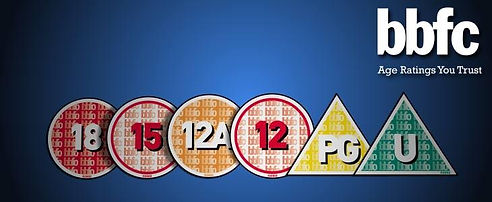
Ethical constraints in Hot Fuzz
Hot Fuzz contains sensitivities such as strong language, gory images, underage drinking and violence. The gory images and violence were proved to be decent for a rating of 15, as the comedic elements would have lessened the impact of the blood and violence within the film. For example, when Angel was in the supermarket trying to catch Skinner or when Skinner trips over a mini Somerfield truck and lands on the edge of the mini Cathedral:
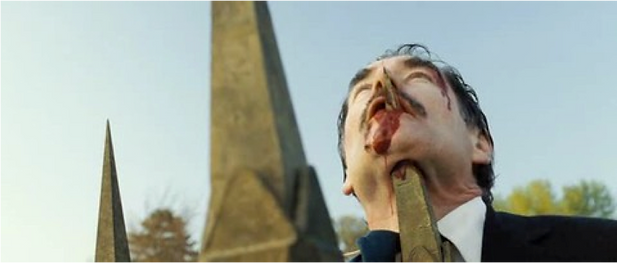
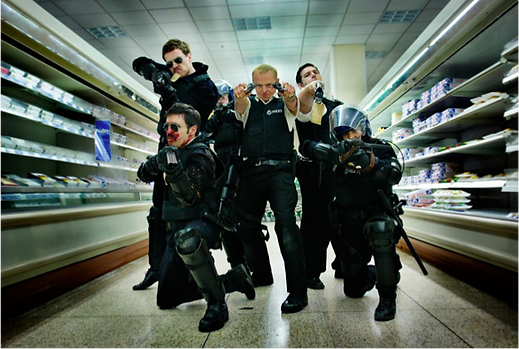
The underage drinking and use of strong language would both be deemed acceptable for a rating of 15 as, once again, the film’s comedic elements and its content has a greater impact on the unprepared audience. For example, at the pub, Angel is prepared to quick the underage boys out by asking their ages, etc.:
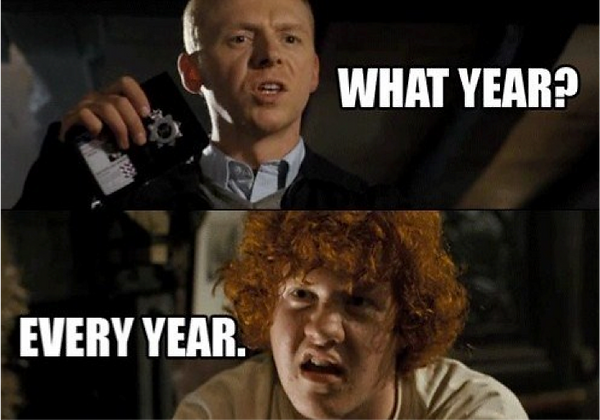
Why do the BBFC need to consult the public?
The BBFC will always keep in touch with the public in order to gather their opinion on ethical debates about film classification. What they have done and what they use are published guidelines based on wide public consultation. Other ways the BBFC provide information to the public is via podcasts or links that lead to extended information, for example, 'Recent film decisions’.
According to the BBFC:
LANGUAGE
There are several uses of strong language (‘f**k’ and ‘motherf**ker’) throughout the film, plus two of very strong language (‘c**t’); one written as part of a list, and another used in a casual, unaggressive context.
VIOLENCE
There are some scenes of strong comic horror and bloody violence, with exaggerated levels of blood and gore. These include a huge pointed piece of masonry dropped from a church roof onto a man’s head, landing with a large blood splash. In a fight scene a man is thrown onto the spire of a model church, so that it pierces his chin and the spire protrudes through his mouth with bloody details visible – although the man continues to talk. A masked axeman bloodily attacks several people, decapitating some of them.
The film also contains some moderate innuendo and sex references.
The representation of the British police officers and Britain in Hot Fuzz:
Hot Fuzz has shown itself to be an Americanised British Film that entwines a variety of different genres together, for example, Action/Comedy that are all reinforced by a sense of farce and comedic elements that feel distinctly British. The film almost juxtaposes the American Cop/Action films against the British, through the use of characters, i.e. Police Officers. It satirises the stereotypical notions of Britishness as British ‘cops’ are seen as lazy and laid-back in comparison to the ‘Bad Boys’ fast-paced thrilling action that portray cops in American films. Angel’s character is a complete contrast to this; he is determined and always ready for work and we can truly see this through the way he wears his uniform – with pride.
Hypodermic Needle Theory:
Also known as ‘Magic Bullet Theory’. This is when the message of the media texts is injected into the audience and how they react to it; it has a predictable effect like a drug, therefore, brainwashing people. This theory treats the audience as being Passive – consuming texts and the messages they contain and reacting to them almost automatically.
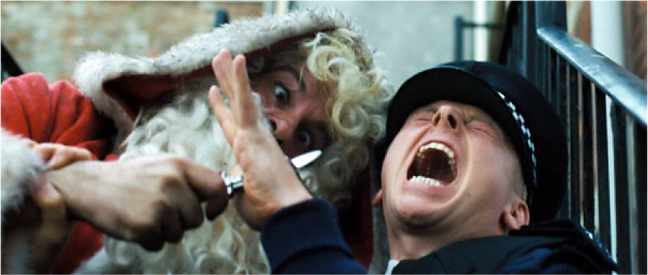


Here, one would expect the audience to laugh at this scene as an immediate reaction. Seeing ‘Santa’ stab a man in his hand has a comical impact, seeing as Santa is originally known as peaceful and giving. These people are seen as ‘Passive’.
Two-Step Flow Model:
Also known as ‘Opinion Leaders’. This is the idea that there are people in society who have a particular understanding of media products and who lead public opinion, for example, those who follow the opinions of critics and TV presenters.
Here, if an opinion leader were to consider this scene as funny, people who follow their opinions would also agree that this scene is funny; if this scene were considered ridiculous or overdramatic, then the audience would also agree to this. For example, a critic may say, "many of the jokes miss their target" - The Daily Mirror, who gave Hot Fuzz a 2/5. Others may give a more positive review saying, "the brilliant minds behind Shaun of the Dead successfully take a shot at the buddy cop genre with Hot Fuzz. The result is a bitingly satiric and hugely entertaining parody" (review by Rotten Tomatoes).
These people are seen as ‘Passive’.
Uses and Gratification Model:
This theory is more open to audiences’ opinion, allowing them to make their own choices about media texts guided by what they want from them. It allows audiences to decide upon what they want to consume and get out of media texts, from escapism and information to personal identity reinforcements and voyeurism.
Here, one would make their own opinions and choices based on what they have obtained from media texts. In this scene, a variety of opinions would be gathered showing different opinions based on this scene alone. For example, elder audiences may consider this scene to be harsh, thus would pity Pegg's character; the younger audience may gain gratification from this scene through a case of Schadenfreude (pleasure derived by someone from another person's misfortune).
These people are seen as ‘Active’.
P5/M3 - Understand Ethical, Legal and Regulatory Issues associated with Media Products.

bottom of page

